市场资讯及洞察

Most traders understand EA portfolio balance through the lens of traditional risk management — controlling position sizes, diversifying currency pairs, or limiting exposure per trade.
But in automated trading, balance is about deliberately constructing a portfolio where different strategies complement each other, measuring their collective performance, and actively managing the mix based on those measurements.
The goal is to create a “book” of EAs that can help diversify performance over time, even when individual strategies hit rough patches.
A diversified mix of EAs across timeframes and assets can, in some cases, reduce reliance on any single strategy. This approach reduces dependency on any single EA’s performance, smooths your overall equity curve, and builds resilience across changing market conditions.
It’s about running the right mix, identifying gaps in your coverage, and viewing your automated trading operation as an integrated whole rather than a collection of independent systems.
Basic Evaluation Metrics – Your Start Point
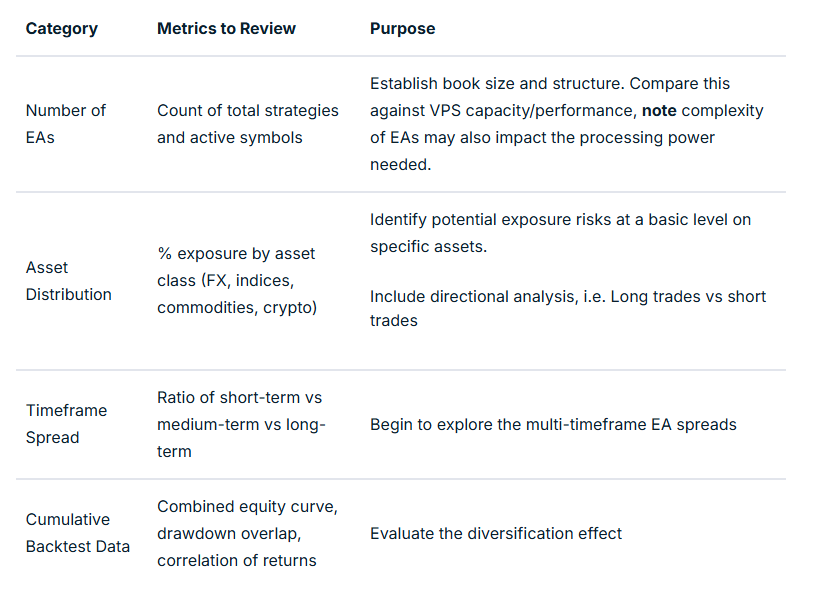
Temporal (timeframe) Balancing
When combined, a timeframe balance (even on the same model and instrument) can help flatten equity swings.
For example, a losing phase in a fast-acting M15 EA can often coincide with a profitable run in an H4 trend model.
Combining this with some market regime and sessional analysis can be beneficial.
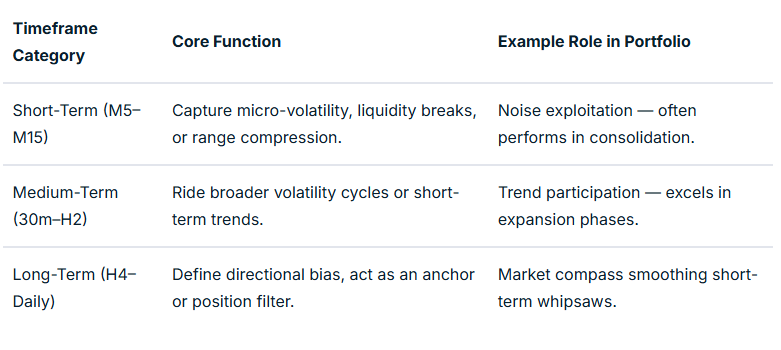
Asset Balance: Managing Systemic Correlation Risk
Running five different EAs on USDJPY might feel diversified if each uses different entry logic, even though they share the same systemic market driver.
But in an EA context, correlation measurement is not necessarily between prices, but between EA returns (equity changes) relating to specific strategies in specific market conditions.
Two EAs on the same symbol might use completely different logic and thus have near-zero correlation.
Conversely, two EAs on a different symbol may feel as though they should offer some balance, but if highly correlated in specific market conditions may not achieve your balancing aim.
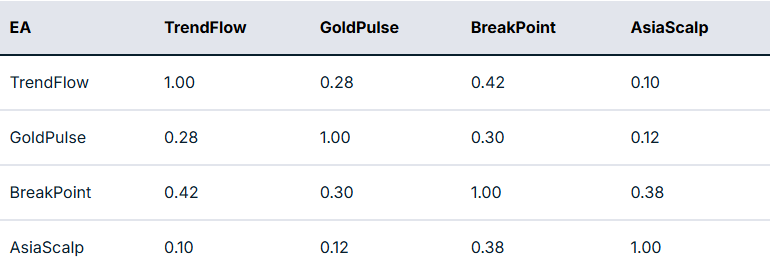
In practical terms, the next step is to take this measurement and map it to potential actionable interventions.
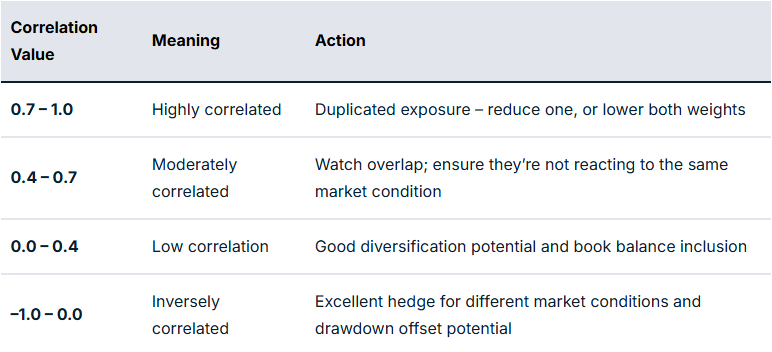
For example, if you have a EURUSD Trend EA and a GBPUSD Breakout EA with a correlation of 0.85, they are behaving like twins in performance related to specific market circumstances. And so you may want to limit exposure to some degree if you are finding that there are many relationships like this.
However, if your gold mean reversion EA correlates 0.25 compared to the rest of your book, this may offer some balance through reducing portfolio drawdown overlap.
Directional and Sentiment Balance
Markets are commonly described as risk-on or risk-off. This bias at any particular time is very likely to impact EA performance, dependent on how well balanced you are to deal with each scenario.
You may have heard the old market cliché of “up the staircase and down the elevator shaft” to describe how prices may move in alternative directions. It does appear that optimisation for each direction, rather than EAs that trade long and short, may offer better outcomes as two separate EAs rather than one catch-all.
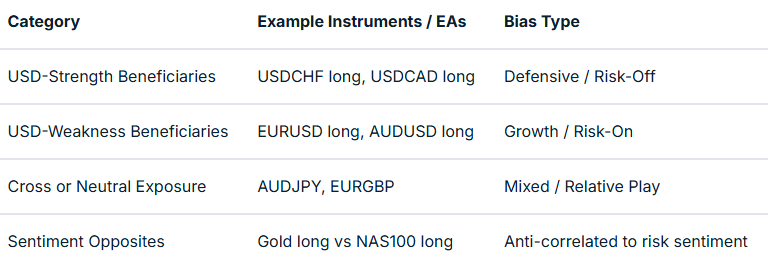
Market Regime and Volatility Balance
Trend and volatility states can have a profound impact on price action, whether as part of a discretionary or EA trading system. Much of this has a direct relationship to time of day, including the nature of individual sessions.
We have a market regime filter that incorporates trend and volatility factors in many EAs to account for this. This can be mapped and tested on a backtest and in a live environment to give evidence of strategy suitability for specific market conditions.
For example, mean reversion strategies may work well in the Asian session but less so in strongly trending markets and the higher volatility of the early part of the US session.
As part of balancing, you are asking questions as to whether you actually have EA strategies suited to different market regimes in place, or are you using these together to optimise book performance?
The table below summarises such an approach of regime vs market mapping:
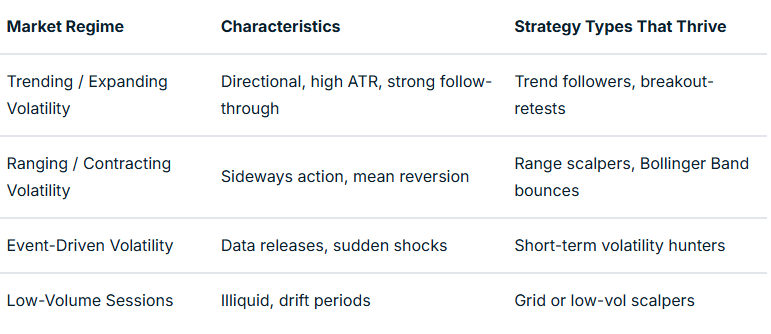
Multi-Level Analysis: From Composition to Interaction
Once your book is structured, the challenge is to turn it into something workable. An additional layer of refinement that turns theory and measurement into something meaningful in action is where any difference will be made.
This “closing the circle” is based on evidence and a true understanding of how your EAs are behaving together. It is the step that takes you to the point where automation can begin to move to the next level.
Mapping relationships with robust and detailed performance evaluation will take time to provide evidence that these are actually making a difference in meeting balancing aims.
To really excel, you should have systems in place that allow ongoing evaluation of the approaches you are using and advise of refinements that may improve things over time.
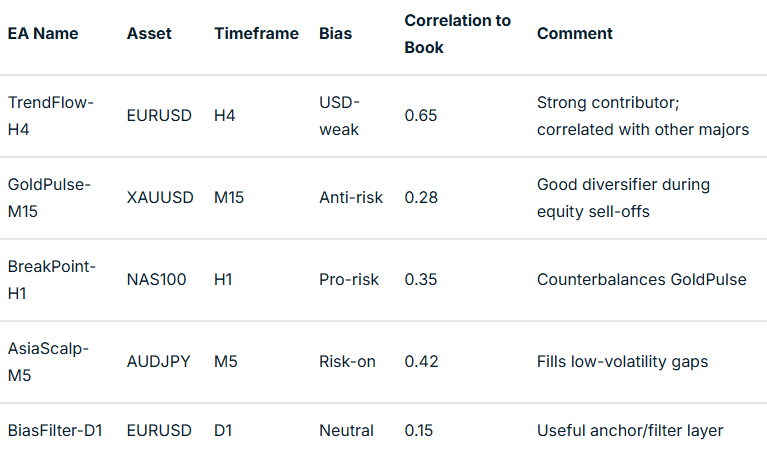
What Next? – Implementing Balance in Practice
Theory must ultimately translate into an executable EA book. A plan of action with landmarks to show progress and maintain motivation is crucial in this approach.
Defining classification tags, setting risk weights, and building monitoring dashboards are all worth consideration.
Advanced EA traders could also consider a supervisory ‘Sentinel’ EA, or ‘mothership’ approach, to enable or disable EAs dynamically based on underlying market metrics and external information integrated into EA coding decision-making.
Final Thoughts
A balanced EA portfolio is not generated by accident; it is well-thought-out, evidence-based and a continuously developing architecture. It is designed to offer improved risk management across your EA portfolio and improved trading outcomes.
Your process begins with mapping your existing strategies by number, asset, and timeframe, then expands into analysing correlations, directional bias, and volatility regimes.
When you reach the stage where one EA’s drawdown is another’s opportunity, you are no longer simply trading models but managing a system of EA systems. To finish, ask yourself the question, “Could this approach contribute to improved outcomes over time?”. If your answer is “yes,” then your mission is clear.
If you are interested in learning more about adding EAs to your trading toolbox, join the new GO EA Programme (coming soon) by contacting [email protected].


周一晚间,美股三大指数集体收跌,打破连日上涨节奏,市场情绪再度转向谨慎。尽管市场普遍预期关税暂停将获延长,但原本预测会延至9月的政策实际仅延至8月1日,较预期提前一个月,也引发市场对中长期贸易政策走向的再评估。与此同时,美国方面正式发布关税通知,对部分亚太及非洲国家的出口产品提升关税,包括对日韩征收25%,部分转运货物关税更高,对马来西亚、哈萨克斯坦、南非、老挝、缅甸等也有不同幅度的加征,未来48小时仍有更多消息公布。尽管欧盟方面释放出谈判进展的信号,但在关税延长期限确定的背景下,短期达成协议的可能性降低。在政策强刺激与关税不确定性交织的背景下,市场对通胀预期重燃。新一轮财政刺激计划预计将释放逾4万亿美元流动性,短期对股市构成支撑,但中长期则可能加剧资产价格波动,市场对“泡沫风险”的讨论升温。板块方面,科技与资源类板块整体回调,AI与量子计算个股普遍承压,特斯拉跌幅接近7%。不过,核能与清洁能源板块表现亮眼,OKLO连续三周回落后强势反弹,测试10周均线支撑成功,VST与CEG也维持稳健走势,铀矿巨头CCJ继续获机构资金青睐,中长期配置逻辑仍在强化。Image另一个亮点来自数字资产赛道。稳定币概念龙头Circle反弹近10%,重回200美元上方,月内有望迎来政策法案的明确进展,若顺利通过,或将成为板块下一轮行情的核心催化。技术形态上,Circle本轮回撤后已完成筑底,七月值得持续关注。商品方面,资源股随期货价格回落调整,铜、铝、稀土及新能源材料表现不佳。公共事业板块则展现出一定抗跌性,在大盘回撤中表现稳定。油价强劲反弹,黄金价格波动不大,市场恐慌指数小幅回升。汇市方面,美元指数反弹站上97关口,澳元兑美元虽短线承压,但日内快速回稳,仍守住0.65上方,美日汇率逼近146,美元兑人民币重新回到7.17之上。今日澳洲市场的焦点将转向澳联储利率决议。市场普遍预期将落地25基点的降息,若如期兑现,预计有望在下午推动股指反弹,特别是对地产、金融等利率敏感型板块形成支撑。联系方式:墨尔本 03 8658 0603悉尼 02 9188 0418中国地区(中文) 400 120 8537中国地区(英文) +248 4 671 903作者:Xavier Zhang | GO Markets 高级分析师


In the world of trading, few stories are as famous as the one behind the Turtle Traders. The Turtle experiment was simple in concept — could absolute beginners, given nothing but a set of rules and two weeks of training, beat the markets?The results of the experiment were extraordinary. Even today, four decades later, many of their principles still echo through our algorithm-dominated trading world.In this article, we’ll revisit the original Turtle strategy, examine how it worked, and explore how this legendary approach could be reimagined for modern traders.
Who Were the Turtles?
The Turtle Traders were the product of a famous bet between trading legend Richard Dennis and his partner William Eckhardt. Dennis believed that trading could be taught; Eckhardt thought that the ability to trade was a set of skills that you are born with. To settle the debate, Dennis placed an ad in the newspaper and selected a group of everyday individuals, none of whom had any prior trading experience.These recruits underwent a two-week crash course in trading, during which they were taught a complete, mechanical system. It was based on trend-following logic, relying on breakouts, strict entry and exit rules, and position sizing based on market volatility. The idea was simple — eliminate emotion, follow the rules, and let the trends do the work.The experiment was a runaway success. As a group, the Turtles reportedly achieved an average annual return of 80%, managing millions in capital and building one of the most talked-about trading systems in history.
Turtle Trading Rules and Instruments
Entry Rules:
The Turtles followed mechanical entry rules based on the concept of trading with the trend. The initial entry criteria were:
- Enter a long position if the price breaks above the 20-day high.
- Enter a short position if the price falls below the 20-day low.
- For a more conservative approach, a second strategy of a 55-day breakout was used as an alternative.
- Orders were placed using buy/sell stop orders triggered by the breakout.
Markets Traded:
The system was applied across a wide range of liquid futures markets:
- Currency Futures: EUR/USD, JPY/USD, GBP/USD, CHF/USD, CAD/USD
- Commodity Futures: Gold, Silver, Crude Oil, Heating Oil, Corn, Wheat, Soybeans, Sugar, Cocoa, Cotton
- Stock Index Futures: S&P 500, Nikkei 225, Dow Jones (DJIA)
- Interest Rate Futures: U.S. Treasury Bonds, Eurodollars
The Importance of Volatility:
They used the Average True Range (ATR) of a 20-days, termed “N”, in many of their calculations to account for the impact of volatility.
Pyramiding (accumulation): Adding to Winning Trades:
The Turtles were also taught to scale into winning trades. This method, known as pyramiding or accumulation, involved adding to a trade if the price moved in their favour. If N (ATR) was 40 points, they would add 0.5 × the Average True Range to the trade. For example, accumulation of a new position would be actioned at 20 and then again at another 20, adding up to a maximum of four positions: the original trade plus three additional entries.
Exits and Risk Management
Initial Stop Loss:
Each trade was initiated with a stop loss placed 2N away from the entry price. This ensured that no single trade risked more than 2% of the account balance.
Trailing Stop:
As the trade progressed and additional units were added, the stop loss was dynamically adjusted using the most recent entry as a reference.The trailing stop for all positions was 2N on the latest (most recent) added position. If the stop was hit, all positions in that trade were closed simultaneously, locking in gains and controlling downside risk.
How Have Markets Changed Since the 1980s?
- Algorithmic and high-frequency trading (HFT) now dominate markets, often resulting in faster and more erratic price movements.
- Trading costs (commissions, spreads) have significantly decreased, enabling more frequent entries and tighter stops.
- Trend persistence has diminished. Markets often reverse more quickly, making it harder for long-trend strategies to succeed without adaptation.
- Forex and futures markets are more liquid, making it easier to execute large positions with less slippage.
- Futures markets have seen changes in volume and type, enabling a greater selection of asset choices.
- Stock indices tend to exhibit more mean reversion, demanding smarter trend filters.
- Breakouts from common levels are less reliable, often resulting in quick reversals due to stop hunting and market manipulation.
- A greater need for confirmation signals before acting on a breakout.
- ATR-based sizing remains relevant but may benefit from more dynamic scaling.
- Rigid stop-loss rules (like 2× ATR) are more likely to be hit due to shorter trend durations.
How Could the Turtle System Be Used Today?
Although the principles underpinning the turtle systems remain valid for trading today, some tweaking of the original criteria and parameter levels would be worth exploring.
Entry Modifications:
Requiring confirmation from trend filters, such as price being above the 200 EMA or RSI values above 55, or perhaps looking for confirmation on larger timeframes, could reduce false signals and improve win rates.Additional volume filters, including relative volume, OBV, and average volume, may add value to decision-makingIncorporating indicators developed since the turtle experiment, such as other variations of the ATR and RSI, Bollinger bands, and Keltner channels, may be worth consideration for the confluence of the basic trend following structure.
Exit and Risk Enhancements:
In the turtles experiment, the ATR was static once the initial trade was entered; the N value remained fixed for that position and all subsequent accumulated positions. Arguably a dynamic ATR instead of a fixed level may be worth consideration to adjust to changing volatility over time.This especially makes sense if you are considering adding additional confluence from other indicators for the initial position.
Trade Like a Turtle
Using the original Turtle approach could be considered a checklist for good practice. Especially when it comes to rule-based system designs, risk management, emotional discipline in execution, and equal attention to entry, accumulation, and exit.Consider testing a “Turtle-inspired” strategy using current instruments and enhanced filters before taking it live. The spirit of the Turtle experiment lives on not just in its rules, but in the key message that trading can be taught. You can learn it, but success depends on sticking to a well-thought-out plan and adhering to the golden rules of trading that still apply today.


刚刚过去的一周,为市场描绘了下半年的三大主线:美国就业数据回暖,资本市场迎来政策资金注入,全球关税问题则仍是最大不确定性。首先,上周非农数据整体优于预期。新增就业人数达14.7万,显著高于市场预估的11万,上月数据也被上修。失业率从4.2%回落至4.1%,整体显示美国就业状况较为稳定。不过,细节显示新增就业中超过一半来自地方与州政府,显示公共领域扩张支撑了就业表现,反映出一定程度的结构性压力。这一数据有效缓解了对经济衰退的担忧,也降低了本月美联储降息的概率。其次,资本面迎来关键催化。美国最新财政刺激法案已顺利通过,计划大幅提高债务上限并实施结构性减税。市场普遍预计,该法案将带来超过4万亿美元的新增流动性,对中期美股形成显著支撑。若短期市场出现回撤,将是布局的重要机会。与此同时,备受关注的对等关税暂停期即将于9号到期。尽管多方传出正在谈判,包括欧盟、泰国等国或已接近协议,但主要经济体仍未正式落笔签署,若无实质性突破,延期至9月的可能性正在上升。有关方面亦表示将在剩余时间内对外公布更多方案。关税调整对全球供应链影响深远,后续进展仍将牵动市场情绪。市场风向的另一抹亮色来自澳洲。澳联储本周将公布利率决议,市场普遍预计将降息25个基点至3.6%,新西兰央行则可能维持利率不变。若政策如期落地,澳股、特别是地产与金融板块或将受益上行。商品与汇市方面,美元指数延续弱势,贵金属与能源价格相对稳定。黄金维持在3330美元/盎司上方,恐慌指数缓慢下行。油价虽受部分国家出口政策影响短线回落,但整体仍保持韧性。比特币持续在10.9万附近震荡,市场关注其能否站上11万大关。汇市方面,澳元兑美元稳定在0.655以上,美元兑日元与人民币亦维持在近期区间内震荡,显示美元疲软尚未形成系统性溢出效应。总结来看,本周市场正处于多空因素交汇点。短期降息预期收敛与资金注入共振,使美股保持强劲动能,但全球贸易政策不确定性仍是悬顶之剑。稳健投资者可关注资源、科技与利率敏感型板块的中期机会。联系方式:墨尔本 03 8658 0603悉尼 02 9188 0418中国地区(中文) 400 120 8537中国地区(英文) +248 4 671 903作者:Xavier Zhang | GO Markets 高级分析师


Most traders obsess over entries, indicators, and setups, but often overlook a simple factor — the time of day that you trade.Time of day affects volatility, liquidity, and when new information enters the market. Ignoring it can turn good setups into frustrating inactivity, or even losses, while embracing it can help you trade with the market, not just the setup.
Why Time of Day Is Important
Markets are not equally active during the whole period they are open. Price action is driven by human behaviour, either on an individual or organisational level. Behaviour commonly follows routines:
- Economic data is released at scheduled times
- Institutions trading during business hours
- Retail traders are more active during specific sessions — in terms of volume and location.
This invariably creates rhythms in the market. By learning to trade with these rhythms, your trades will often require less confirmation, you improve stop placement, and have cleaner follow-through on trading ideas.
The Global Trading Clock
The trading day is broadly broken into three main sessions: Asia, Europe, and the US. Each has its own “character,” and benefits vary based on which time zone best aligns with your strategy.
1. Asia (Tokyo)
10pm –7am GMT: Markets are generally quieter except JPY and AUD FX pairs and index CFDs. Common characteristics include:
- Lower liquidity
- Range-bound behaviour
- Risk of false breakouts
Reversion strategies may do well in such market conditions as well as setting up highs and lows, which may be useful references for sessions later in the day.
2. Europe (London)
7am–4pm GMT: Increased volatility and volume are seen during the European session across many asset classes. The opening of the LME can influence metals prices, and US futures may respond accordingly to increased volatility. Common characteristics include:
- Large institutional flows
- Strong trends can begin
- Overlaps with NY for 2 hours
Breakout strategies using Asian session highs or lows as reference (or previous days' US session) may outperform. And trend continuation and reversal approaches on the back of new data coming out of Europe may also be common. The two-hour crossover with the subsequent US session can also be an important change in market conditions.
3. US (New York)
12pm–9pm GMT: Volatility spikes may occur at US equity market open and significant data releases with global asset class impact are often released at 8.30am US Eastern time. Common characteristics include:
- Major economic releases
- US equity open creates short-term momentum
- Slower into the late session
Fast moves might be prevalent early in the day, suggesting short-term momentum-supported new trend set-ups may outperform. Reversals around the middle of the day are also not uncommon.The Federal Reserve interest rate decisions are always in the early afternoon in the US, which can flip market sentiment.
The Intra-Session Rhythm
It is not only session-to-session changes that can often be seen on price charts. Within each session, price often has a tendency to move in waves. So, as a general rule, you may see:
- Early session: bursts of volatility and institutional positioning
- Mid-session: consolidation or retracements
- Late session: thinning liquidity, profit-taking, fakeouts
Why Most Traders Miss This
During strategy development, many strategies are tested on charts without considering what time the setup occurred.A 15-minute candle during the London open isn’t the same as one during the Australian lunch break.So, if you start taking breakouts in low-volume periods, trading reversals just before news, or entering trends during midday doldrums, these may have less chance of meeting the goals for that particular trade.
How to Use Time of Day as a Filter Practically
1. Mark Your Session Windows
On your chart, visually block out the London open, NY open, and overlap. Use vertical lines or shading — this will help you historically see what happens at these key times.*Note: We are developing a free indicator for this that you can place on a chart. Email [email protected] if you are interested.
2. Backtest by Session
You can split potential trades by session ‘time blocks’ that look back over time. Strategy types often work better during specific hours:
- Breakouts work 7am–10am GMT
- Mean reversion thrives 2am–5am GMT
- Reversals occur more often post-3pm GMT
Using your existing setups (or even previous trades), look at a sample to see what may have happened. 3. Add Time as a Trade FilterOnce you have some evidence from, test out simple rules like:
- “Only take trend trades between 7am–11am GMT”
- “No breakout entries after 3pm NY”
If you can code (or have access to someone who can), then you can backtest this quickly to see the impact of these filters.
4. Know the News Calendar
Most high-impact data is released at predictable times — make knowing what is happening and when part of your daily trending agenda. These contribute to the characteristics of a session, but also may flip what is standard on its head. Reference in your plan the major data points and how you are going to manage potential entry setups.
Trade With the Market — Not Just the Setup
The best trades don’t just have good structure; they also happen at the right time.Logically, if you want cleaner trade setups, high-probability entries, and improved consistency, then aligning your trading strategies with the market clock makes sense.It’s a simple shift that most traders ignore — perhaps to their detriment. Finding the best time of day to trade for your trading strategy could be one of the things that helps develop your trading edge.
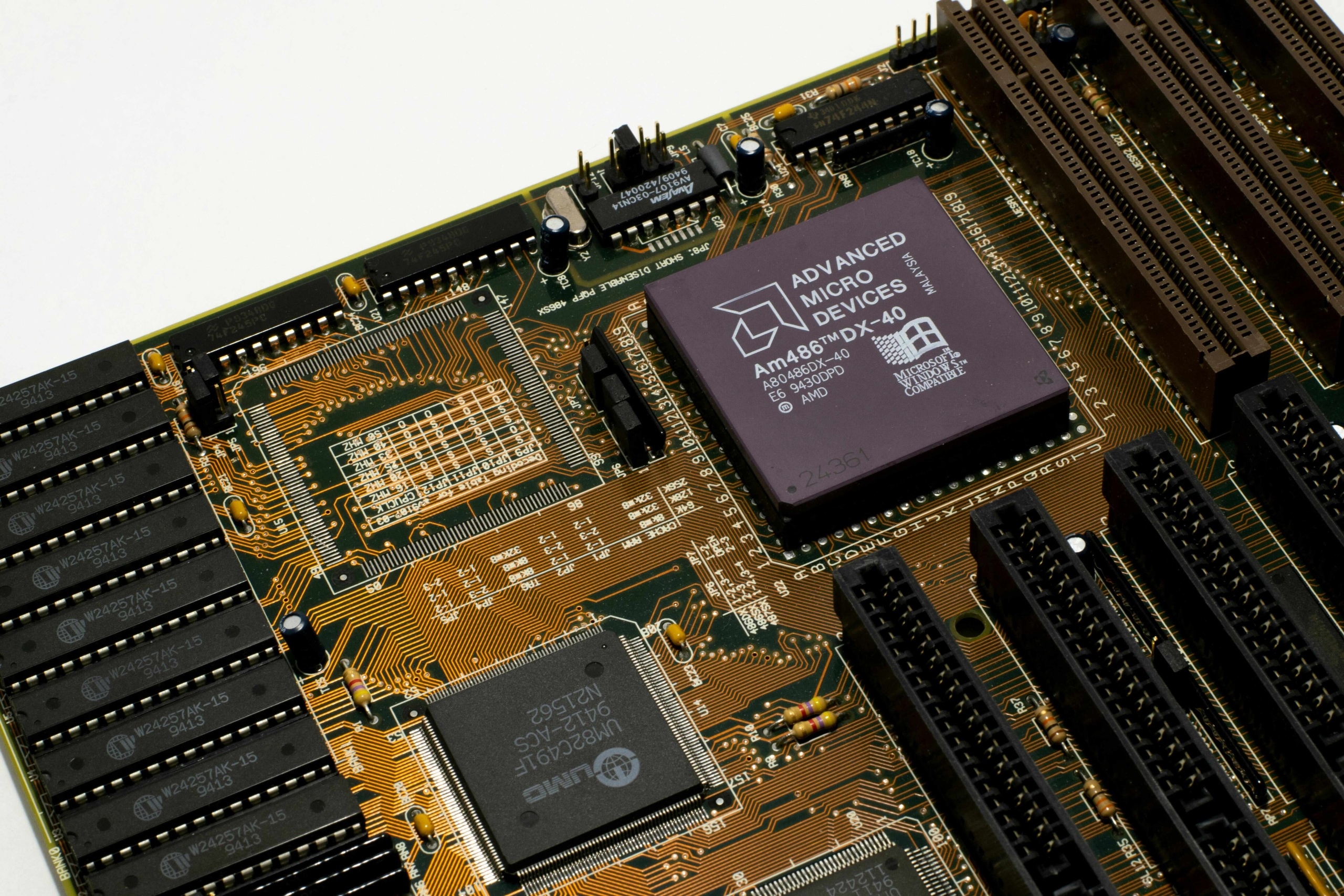

在 GO Markets 本周财经分析视频里,我们简单介绍了英伟达股东大会的情况,英伟达市值节节攀升成功拿下全球第一的宝座,被狠狠夸了一波,但是也留了一个小小的坑,就是英伟达的竞争对手AMD究竟如何能否上演弯道超车?今天我们就来填一下这个坑,有请今天的主角——AMD。AMD:大家好我叫AMD,中文名是美国超微公司,我和英伟达既是战友也是对手,二十年前全在卷CPU的时候,我和英伟达就一起瞄向了GPU市场,英伟达将全部押在GPU的发展上,而我在布局GPU的同时也没有扔掉CPU的研发。CPU和GPU呢其实就像将军和士兵,CPU负责指挥调度、决策管理、复杂逻辑,聪明但数量少,适合排兵布阵;GPU负责执行大量重复指令,数量多,适合重复冲锋打仗。当时大多数公司都在培养将军,让自家将军能力越来越强,但我们认为要想打胜仗只有将军不行,也要有一群干活的大头兵,毕竟三个臭皮匠还能顶一个诸葛亮。现在看呢,当时的方向是正确的,随着AI潮流加之之前的挖矿热潮,GPU的市场远超CPU。因为挖矿(比如比特币、以太坊)是解数学题,本质上就是重复试错、运算速度越快中矿概率越高,这种任务特点就是不复杂,但超级重复,每个小兵都能并行干。而AI 的本质是大量矩阵乘法(尤其是神经网络),比如输入一段文字,模型需要成千上万次矩阵加权计算生成输出,这些计算结构类似,计算量巨大,也适合用 GPU 这种“一群小兵并排算乘法”的架构。这样GPU的市场潜力被无限挖掘,英伟达也因之前的全部押注,市场份额遥遥领先,市值暴涨。我则因为CPU,GPU双管齐下,没能和英伟达平分天下。但目前在这两个市场我都处于行业老二,CPU市场虽不及英特尔,GPU市场也不及英伟达,但我都在加速追赶逐步缩小和第一的差距。CPU领域近年来个人认为已经实现了从“陪跑”到“并跑”甚至“局部超车”的转变,特别是在桌面处理器和服务器市场,与传统霸主 Intel 的竞争格局正在发生变化。且英特尔最近表现确实不太好,夸张说已经不再构成威胁。GPU领域我怎么追赶英伟达呢,这里咱先聊一下英伟达的弊端:1. 价格过高,供不应求,中小客户难以获得资源。2. 生态封闭,平台锁定严重,英伟达成功的秘诀之一是 CUDA 平台,但它同时也是一把“双刃剑”。CUDA 是闭源的,企业部署受限于英伟达许可和平台绑定。3. AI 战略集中于训练,而AI推理的需求正在爆炸增长。4. 未来产品周期(如 Blackwell)长,留出足够时间给我追赶。而我的优势则是:1. 推理为王,大模型训练只是 AI 生命周期的一部分,真正决定商业规模的是推理部署阶段。2. 成本效率压制,对于大量部署 AI 应用的企业,尤其是 SaaS 模型服务商和中小模型公司,性价比才是商业化落地的关键。3. 开放架构带来的战略灵活性,企业可自由使用、修改、定制,不受供应链和许可限制,更受欢迎于政府、科研等环境。4. 就体现出我双管齐下布局的优势了,我拥有强大的 CPU 技术(Zen 架构),能够在 AI 时代实现 CPU + GPU 融合架构(APU),可以实现降低通信延迟,提升数据共享效率。好的,AMD结束发言。我们来回答最初的问题,AMD到底能不能实现超车呢?我认为AMD不是超越替代英伟达,而是平衡与分裂的开始,它正在打开新的市场空间。在 AI 训练仍由英伟达主导的同时,AMD 将在AI 推理市场,边缘 AI 部署,性价比和敏感客户群体中扮演越来越关键的角色。英伟达不再是“唯一选择”,AMD 的存在让客户第一次拥有了真正的“第二路径”。这或许才是 AMD “超越”英伟达的真正意义所在。不可否认的讲,AMD发展确实迅速,正在蚕食部分英伟达的市场。联系方式:墨尔本 03 8658 0603悉尼 02 9188 0418中国地区(中文) 400 120 8537中国地区(英文) +248 4 671 903作者:Mill Li | GO Markets 墨尔本中文部


昨夜美股再度逆转盘前跌势,纳指与标普双双收涨并续创新高,道指小幅收平。市场情绪在多重博弈之下保持强劲,尤其是在就业与关税政策不确定性加剧的背景下,风险资产依然获得资金青睐。外贸方面,美国与越南达成新一轮关税协议引发市场热议。协议显示,美国对部分进口货物征收高达20%至40%的税率,而越南方面则几乎实现全面零关税。这一安排被视为双边贸易策略的关键转折,短期内有助缓解美国部分产业压力,同时也可能提升国内通胀预期。关税暂停期即将结束,市场密切关注接下来与其他贸易伙伴的协商结果。就业数据方面,小非农数据意外转负,尽管通常波动较大,但仍为今晚的非农就业报告增添不确定性。一旦大非农数据同样不及预期,市场将大幅提升对美联储年内降息的押注,从而进一步推升资产价格,而经济滞胀的担忧也可能同步升温。板块方面,资源股强势领涨。金属、钢铁、铜和稀土板块普遍上涨,反映市场对全球通胀和原材料价格上涨的预期升温。AI概念整体表现稳健,特斯拉二季度交付超预期,股价大涨近5%,英伟达、苹果涨超2%,谷歌、Meta也均表现良好。核能板块波动不大,铀价保持稳定,核技术股表现持平。量子计算板块表现突出,RGTI受机构增持评级激励大涨超15%,IONQ和QUBT涨幅超过10%。市场流动性方面,美元指数晚盘止跌但涨幅有限;金价在冲破3350美元后早盘小幅调整;油价走强,美油一度突破68美元大关。比特币维持在10.8万美元上方,保持强势整理格局。恐慌指数继续温和下行,市场整体风险偏好仍然良好。外汇市场方面,美元表现仍偏弱,澳元兑美元维持高位震荡,美日汇率基本持稳,人民币汇率夜间波动不大,市场交投情绪平稳。联系方式:墨尔本 03 8658 0603悉尼 02 9188 0418中国地区(中文) 400 120 8537中国地区(英文) +248 4 671 903作者:Xavier Zhang | GO Markets 高级分析师

